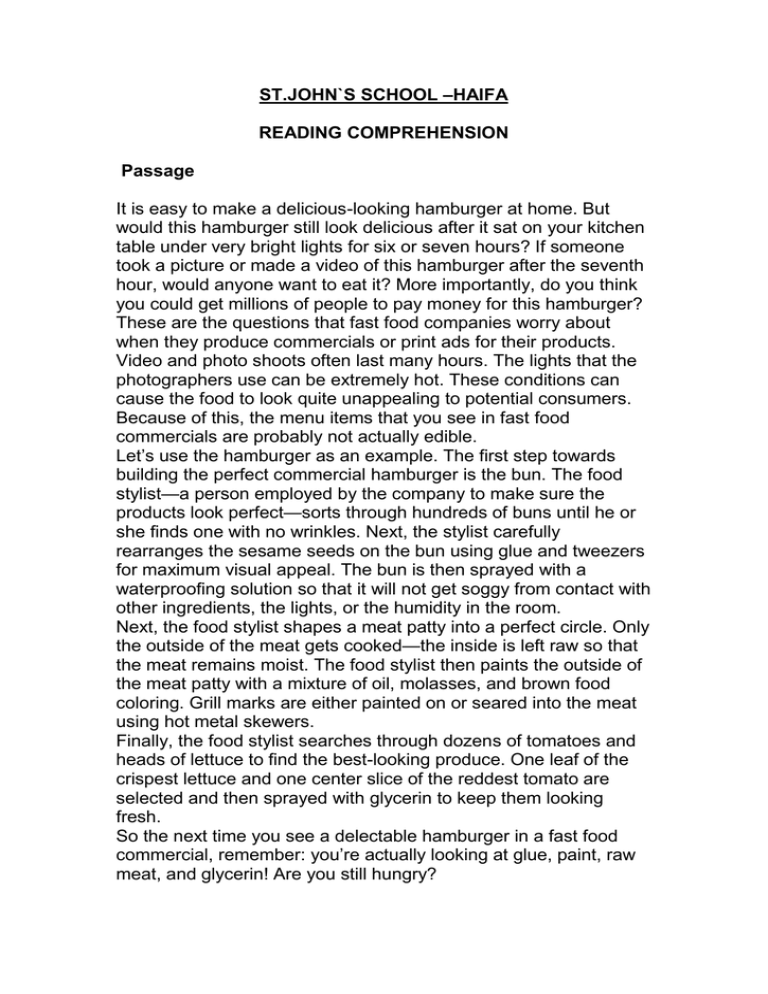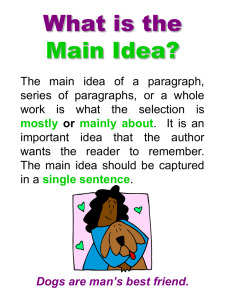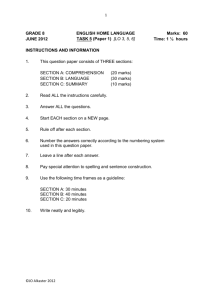
ST.JOHN`S SCHOOL –HAIFA
READING COMPREHENSION
Passage
It is easy to make a delicious-looking hamburger at home. But
would this hamburger still look delicious after it sat on your kitchen
table under very bright lights for six or seven hours? If someone
took a picture or made a video of this hamburger after the seventh
hour, would anyone want to eat it? More importantly, do you think
you could get millions of people to pay money for this hamburger?
These are the questions that fast food companies worry about
when they produce commercials or print ads for their products.
Video and photo shoots often last many hours. The lights that the
photographers use can be extremely hot. These conditions can
cause the food to look quite unappealing to potential consumers.
Because of this, the menu items that you see in fast food
commercials are probably not actually edible.
Let’s use the hamburger as an example. The first step towards
building the perfect commercial hamburger is the bun. The food
stylist—a person employed by the company to make sure the
products look perfect—sorts through hundreds of buns until he or
she finds one with no wrinkles. Next, the stylist carefully
rearranges the sesame seeds on the bun using glue and tweezers
for maximum visual appeal. The bun is then sprayed with a
waterproofing solution so that it will not get soggy from contact with
other ingredients, the lights, or the humidity in the room.
Next, the food stylist shapes a meat patty into a perfect circle. Only
the outside of the meat gets cooked—the inside is left raw so that
the meat remains moist. The food stylist then paints the outside of
the meat patty with a mixture of oil, molasses, and brown food
coloring. Grill marks are either painted on or seared into the meat
using hot metal skewers.
Finally, the food stylist searches through dozens of tomatoes and
heads of lettuce to find the best-looking produce. One leaf of the
crispest lettuce and one center slice of the reddest tomato are
selected and then sprayed with glycerin to keep them looking
fresh.
So the next time you see a delectable hamburger in a fast food
commercial, remember: you’re actually looking at glue, paint, raw
meat, and glycerin! Are you still hungry?
Questions
1) The author’s primary purpose is to
A. convince readers not to eat at fast food restaurants
B. explain how fast food companies make their food look delicious
in commercials
C. teach readers how to make delicious-looking food at home
D. criticize fast food companies for lying about their products in
commercials
2) According to the passage, fast food companies use things like
glue and glycerin on hamburgers that appear in advertisements
because
I. no one actually has to eat the food used in the commercial
II. it is important that people who see these advertisements would
pay for the food being advertised
III. filming a commercial or a print ad can take a very long time
A. l only
B. I and II only
C. II and III only
D. I, II, and III
3) As used in paragraph 2, something is edible if it
A. can safely be eaten
B. looks very delicious
C. seems much smaller in real life
D. tastes good
4) According to the passage, a food stylist working on a hamburger
commercial might use glue to
A. make sure the meat patty stays attached to the bun
B. keep the sesame seeds on the bun in perfect order
C. arrange the lettuce on the tomato
D. hold the entire hamburger together
5) Based on information in the passage, it is most important for the
lettuce and tomato used in a fast food hamburger commercial to
A. have a great taste
B. be the perfect shape and size
C. appear natural
D. look fresh
6) Imagine that the author decides to change this passage so that
it talks about a cheeseburger instead of a hamburger. Assume that
the cheese goes directly on top of the hamburger patty. If the
author wants to include a paragraph about how the food stylist
designs the cheese and places it on the meat patty, this new
paragraph would best fit into the passage
A. between paragraph 2 and paragraph 3
B. between paragraph 3 and paragraph 4
C. between paragraph 4 and paragraph 5
D. between paragraph 5 and paragraph 6
7) As used in the final paragraph, which is the best synonym for
delectable?
A. disgusting
B. familiar
C. fake
D. delicious
© Copyright EnglishForEveryone.Org, 2012. All rights reserved.
Answers and Explanations
1) B
In paragraph 1, the author poses a series of questions about how
to keep a hamburger looking delicious for hours under hot lights. In
paragraph 2, the author suggests that this problem is exactly what
fast food companies must worry about when they make
advertisements for their food. The author explains that the
conditions used during photo shoots “can cause the food to look
quite unappealing to potential consumers. Because of this, the
menu items that you see in fast food commercials are probably not
actually edible.” In paragraphs 3-5, the author gives a step-by-step
explanation of what the food stylist does to keep a hamburger
looking delicious for hours. Since the author poses a question and
then delivers an explanation, we can understand that the author’s
purpose is to explain how fast food companies make their food
look delicious in commercials. Therefore (B) is correct. The author
does not use a persuasive tone or try in other ways to convince
people not to eat at fast food restaurants. This means (A) is
incorrect. Although a reader might be able to use the information
presented in the passage to make similar food at home, the
primary purpose is to explain, not to teach. This means (C) is
incorrect. The author does not use a harsh tone to criticize fast
food companies; instead, he or she explains the facts about how
food commercials are made. This means (D) is incorrect.
2) C
Although it is likely that no one actually has to eat the food used in
commercials, the author does not state this in the passage. This
eliminates option (I). In paragraph 1, the author asks readers to
imagine making a hamburger and letting it sit under hot lights for
six or seven hours. The author then asks: “If someone took a
picture or made a video of this hamburger after the seventh hour,
would anyone want to eat it? More importantly, do you think you
could get millions of people to pay money for this hamburger?”
Then, in paragraph 2, the author states that fast food companies
have to worry about these questions. These sentences suggest
that fast food companies think that it is important that people would
pay for the food being advertised, so they must make the food look
very good. Glue and glycerin are some of the things they use to
make the food look good. This supports option (II). In paragraph
2, the author states, “Video and photo shoots often last many
hours.” Since these photo shoots can take a very long time, the
food stylist uses things like glue and glycerin to keep the food
looking fresh. This supports option (III). Therefore (C) is correct.
3) A
edible (adjective): suitable for a human being to eat; eatable.
In paragraph 2, the author states that “the menu items that you see
in fast food commercials are probably not actually edible.” In the
rest of the passage, the author explains that the food used in fast
food commercials contains things like glue, paint, and raw meat,
which are not things that people should eat. From the context, we
can understand that the food used in commercials is probably not
suitable to be eaten. This means that if something is edible, you
can eat it safely. Therefore (A) is correct. The food in fast food
commercials looks delicious, but it is not actually edible. This
means that edible cannot mean to look very delicious. Therefore
(B) is incorrect. The passage does not contain any information
about the size of the food in commercials versus real life, so (C) is
incorrect. Since the food contains glue and paint, it probably does
not taste good, but more importantly it is not safe to eat. The big
question when considering whether something is edible is one of
safety, not a question of taste. This means (D) is not the best
answer.
4) B
In paragraph 3, the author notes that a food stylist uses glue and
tweezers to carefully rearrange “the sesame seeds on the bun…for
maximum visual appeal.” Therefore (B) is correct. The passage
does not contain information to support answer choices (A), (C),
and (D). Therefore they are incorrect.
5) D
In paragraph 3, the author claims that a food stylist looking for the
perfect lettuce and tomato searches for the “crispest lettuce” and
“the reddest tomato.” The food stylist then sprays the lettuce and
tomato with glycerin “to keep them looking fresh.” From these
sentences, we can understand that freshness is the most
important quality when the food stylist deals with lettuce and
tomatoes. Therefore (D) is correct. There is no information in the
passage to make us think the lettuce and tomato should have a
great taste; in fact, if they are sprayed with glycerin, they probably
do not taste good at all. This eliminates (A). Although the food
stylist may choose produce based on shape and size, and he or
she may want the food to appear natural, the passage suggests
that the most important quality is that the lettuce and tomato look
fresh. This rules out (B) and (C).
6) C
After paragraphs 1 and 2, which introduce the main idea, this
passage is organized according to the steps one generally follows
in making a hamburger: first the bun (paragraph 3), then the meat
(paragraph 4), and finally the lettuce and tomatoes (paragraph 5).
If the author wanted to include a paragraph about cheese, which
goes directly on top of the meat, but beneath the lettuce and
tomatoes, it would likely come between paragraphs 4 and 5.
Therefore (C) is correct. It would not make sense to talk about
putting the cheese on the hamburger before you explain how the
hamburger patty is made, so this rules out (A) and (B). Putting the
paragraph about cheese after the paragraph about the lettuce and
tomato would indicate that the lettuce and tomato are put on the
hamburger, then the cheese on top of the lettuce and tomato. But
the question tells us that the cheese goes on top of the hamburger
patty, not on top of the produce. This means (D) is incorrect.
7) D
delectable (adjective): greatly pleasing to the taste; delicious.
The question asks us to find the best synonym. Synonyms are words that
have nearly the same meanings. In the final paragraph, the author
writes: “So the next time you see a delectable hamburger in a fast food
commercial, remember: you’re actually looking at a glue, paint, raw
meat, and glycerin! Are you still hungry?” We understand that the
hamburgers in fast food commercials are designed to look delicious,
because in paragraph 1 the author discusses the problem of making “a
delicious-looking hamburger” that people would pay money for.
According to the rest of the passage, however, the hamburger in a fast
food commercial is not actually delicious, because it is made of things
like glue and paint. While it looks delectable, or delicious, it is not good
to eat. Therefore (D) is correct. It does not make sense to say “the next
time you see a disgusting hamburger in a fast food commercial,”
because we have learned in the passage that the food stylist works very
hard to make the hamburger look like it tastes good. This means (A) is
incorrect. A hamburger in a commercial would look familiar whether it
tastes good or not. But the meaning of the final sentence is that while
the hamburger looks good, it actually would taste terrible. This means
(B) is incorrect. A hamburger in a commercial does not look fake, as we
have learned from the passage that the food stylist works to make it
look fresh and appetizing. Therefore (C) is incorrect






